Corporate and Financial Accounting 2 Report: Mergers and Acquisitions
VerifiedAdded on 2022/11/17
|11
|3575
|299
Report
AI Summary
This report provides a comprehensive overview of corporate and financial accounting, focusing on business combinations such as mergers and acquisitions. It details the application of AASB standards, exploring the purchase method and the differences between consolidated and equity methods for preparing financial statements. The report examines intragroup transactions, emphasizing their elimination in consolidated statements to prevent misrepresentation. It also addresses non-controlling interest disclosure requirements and the challenges encountered during consolidations, particularly when assets are reported at historical value. The analysis underscores the importance of accurate accounting to avoid financial statement misrepresentation, ensuring fair representation of a business's financial position and performance.
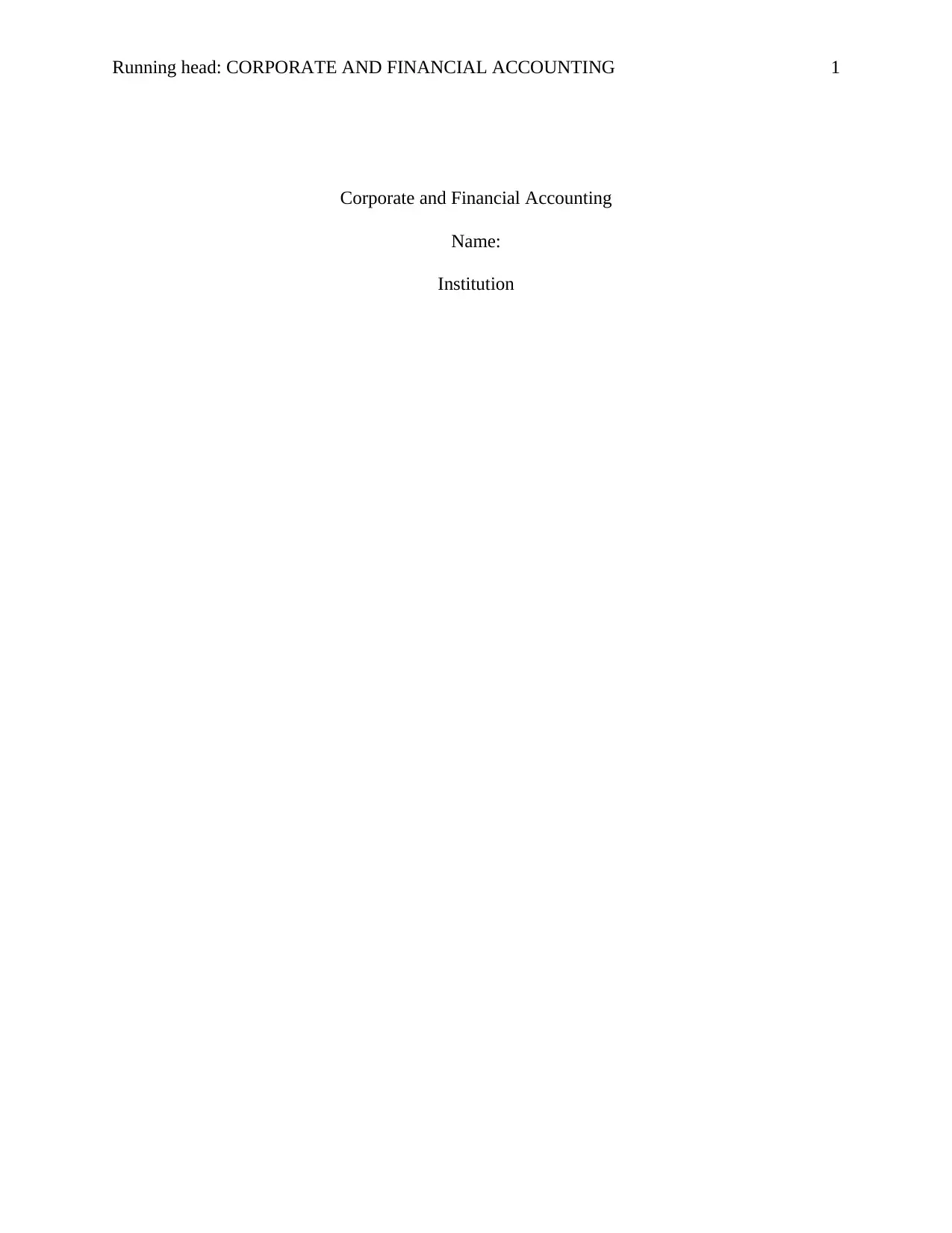
Running head: CORPORATE AND FINANCIAL ACCOUNTING 1
Corporate and Financial Accounting
Name:
Institution
Corporate and Financial Accounting
Name:
Institution
Paraphrase This Document
Need a fresh take? Get an instant paraphrase of this document with our AI Paraphraser
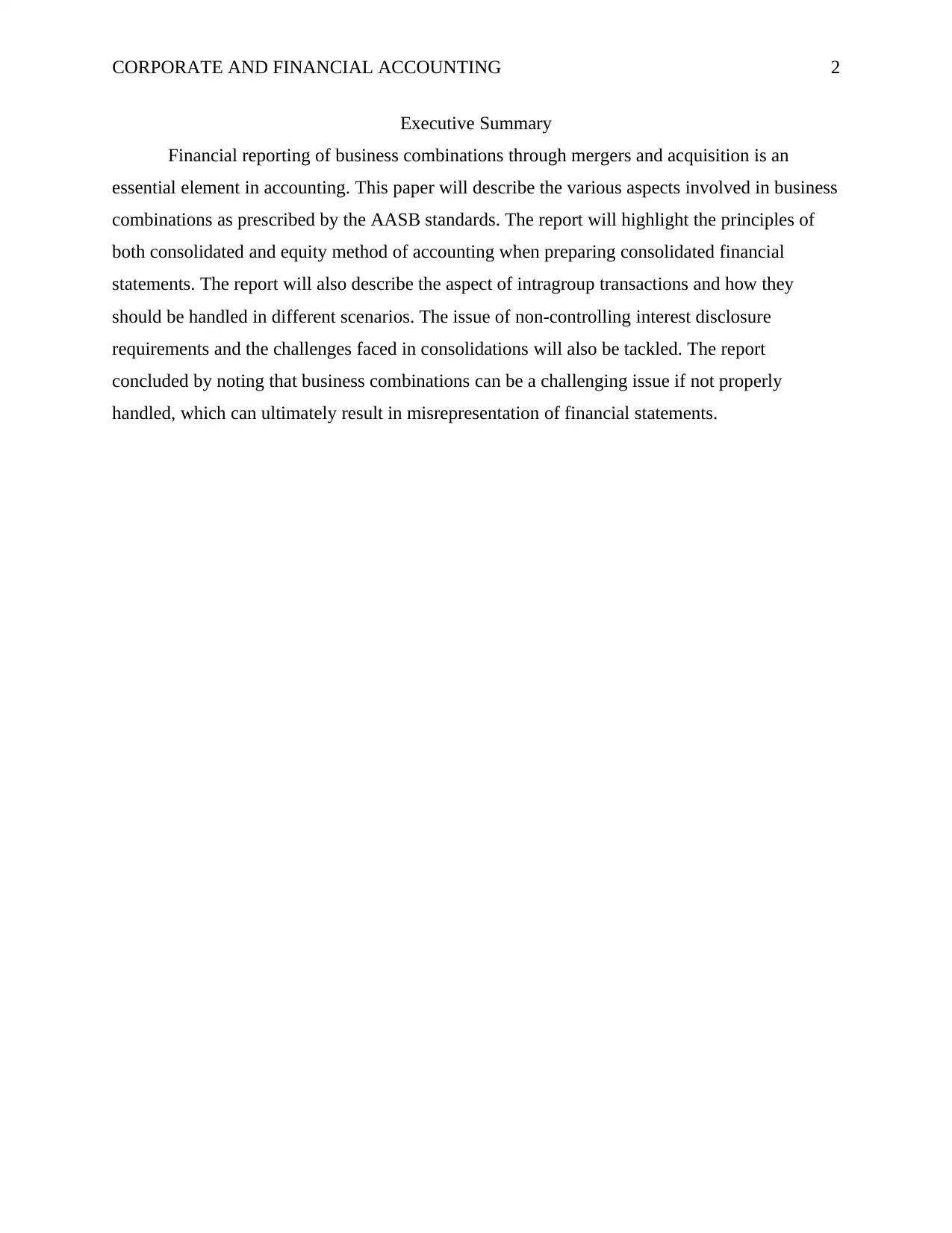
CORPORATE AND FINANCIAL ACCOUNTING 2
Executive Summary
Financial reporting of business combinations through mergers and acquisition is an
essential element in accounting. This paper will describe the various aspects involved in business
combinations as prescribed by the AASB standards. The report will highlight the principles of
both consolidated and equity method of accounting when preparing consolidated financial
statements. The report will also describe the aspect of intragroup transactions and how they
should be handled in different scenarios. The issue of non-controlling interest disclosure
requirements and the challenges faced in consolidations will also be tackled. The report
concluded by noting that business combinations can be a challenging issue if not properly
handled, which can ultimately result in misrepresentation of financial statements.
Executive Summary
Financial reporting of business combinations through mergers and acquisition is an
essential element in accounting. This paper will describe the various aspects involved in business
combinations as prescribed by the AASB standards. The report will highlight the principles of
both consolidated and equity method of accounting when preparing consolidated financial
statements. The report will also describe the aspect of intragroup transactions and how they
should be handled in different scenarios. The issue of non-controlling interest disclosure
requirements and the challenges faced in consolidations will also be tackled. The report
concluded by noting that business combinations can be a challenging issue if not properly
handled, which can ultimately result in misrepresentation of financial statements.
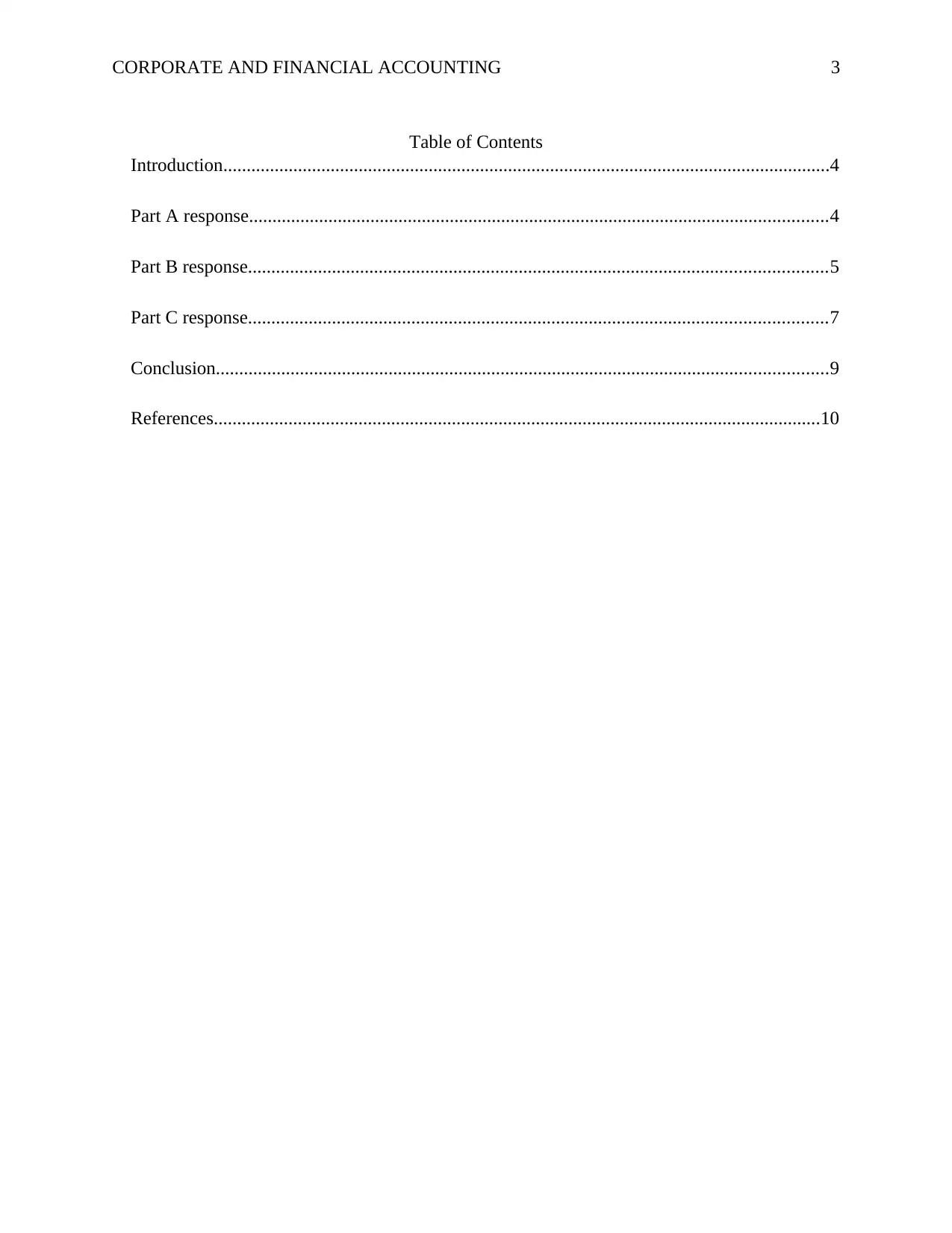
CORPORATE AND FINANCIAL ACCOUNTING 3
Table of Contents
Introduction..................................................................................................................................4
Part A response............................................................................................................................4
Part B response............................................................................................................................5
Part C response............................................................................................................................7
Conclusion...................................................................................................................................9
References..................................................................................................................................10
Table of Contents
Introduction..................................................................................................................................4
Part A response............................................................................................................................4
Part B response............................................................................................................................5
Part C response............................................................................................................................7
Conclusion...................................................................................................................................9
References..................................................................................................................................10
⊘ This is a preview!⊘
Do you want full access?
Subscribe today to unlock all pages.

Trusted by 1+ million students worldwide
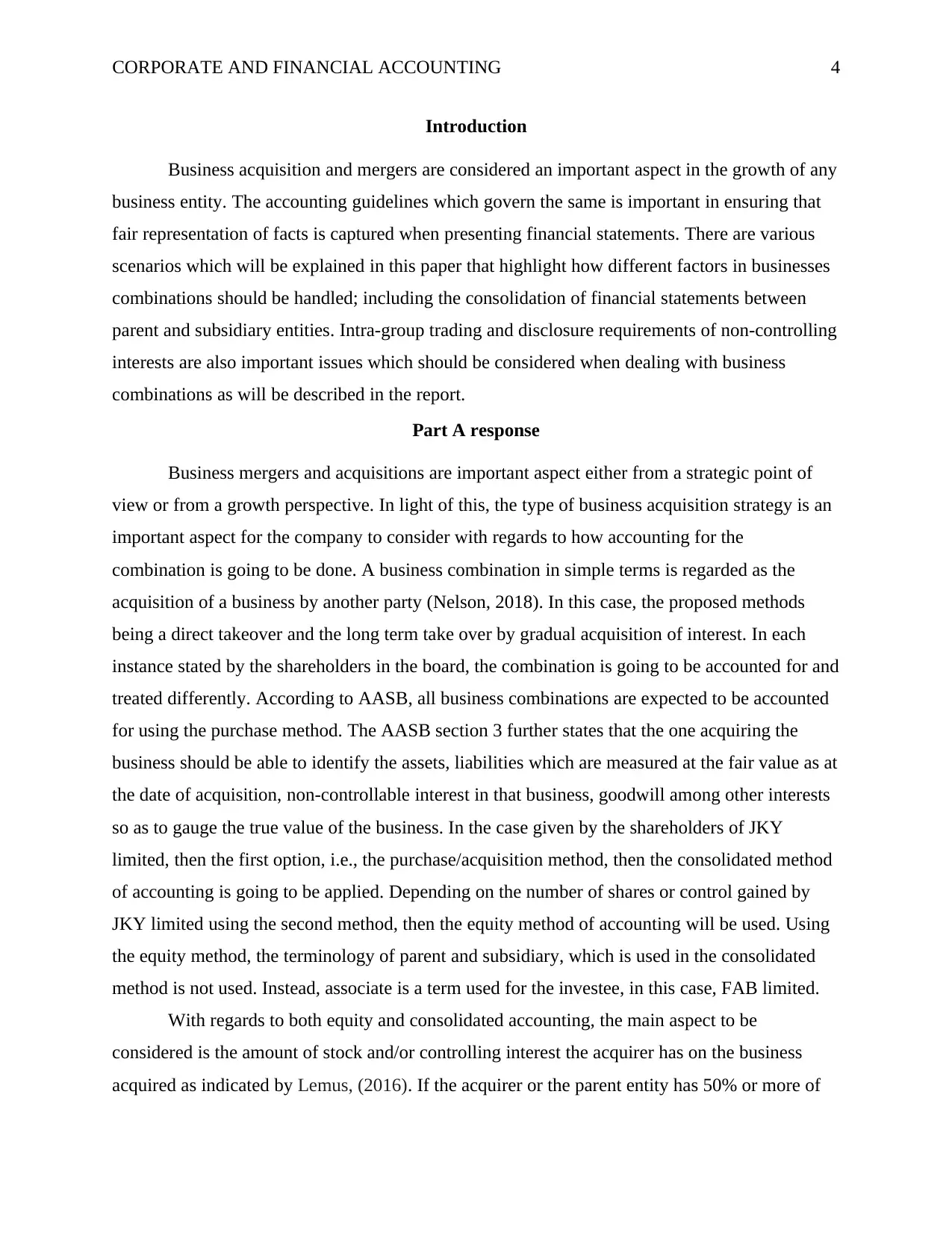
CORPORATE AND FINANCIAL ACCOUNTING 4
Introduction
Business acquisition and mergers are considered an important aspect in the growth of any
business entity. The accounting guidelines which govern the same is important in ensuring that
fair representation of facts is captured when presenting financial statements. There are various
scenarios which will be explained in this paper that highlight how different factors in businesses
combinations should be handled; including the consolidation of financial statements between
parent and subsidiary entities. Intra-group trading and disclosure requirements of non-controlling
interests are also important issues which should be considered when dealing with business
combinations as will be described in the report.
Part A response
Business mergers and acquisitions are important aspect either from a strategic point of
view or from a growth perspective. In light of this, the type of business acquisition strategy is an
important aspect for the company to consider with regards to how accounting for the
combination is going to be done. A business combination in simple terms is regarded as the
acquisition of a business by another party (Nelson, 2018). In this case, the proposed methods
being a direct takeover and the long term take over by gradual acquisition of interest. In each
instance stated by the shareholders in the board, the combination is going to be accounted for and
treated differently. According to AASB, all business combinations are expected to be accounted
for using the purchase method. The AASB section 3 further states that the one acquiring the
business should be able to identify the assets, liabilities which are measured at the fair value as at
the date of acquisition, non-controllable interest in that business, goodwill among other interests
so as to gauge the true value of the business. In the case given by the shareholders of JKY
limited, then the first option, i.e., the purchase/acquisition method, then the consolidated method
of accounting is going to be applied. Depending on the number of shares or control gained by
JKY limited using the second method, then the equity method of accounting will be used. Using
the equity method, the terminology of parent and subsidiary, which is used in the consolidated
method is not used. Instead, associate is a term used for the investee, in this case, FAB limited.
With regards to both equity and consolidated accounting, the main aspect to be
considered is the amount of stock and/or controlling interest the acquirer has on the business
acquired as indicated by Lemus, (2016). If the acquirer or the parent entity has 50% or more of
Introduction
Business acquisition and mergers are considered an important aspect in the growth of any
business entity. The accounting guidelines which govern the same is important in ensuring that
fair representation of facts is captured when presenting financial statements. There are various
scenarios which will be explained in this paper that highlight how different factors in businesses
combinations should be handled; including the consolidation of financial statements between
parent and subsidiary entities. Intra-group trading and disclosure requirements of non-controlling
interests are also important issues which should be considered when dealing with business
combinations as will be described in the report.
Part A response
Business mergers and acquisitions are important aspect either from a strategic point of
view or from a growth perspective. In light of this, the type of business acquisition strategy is an
important aspect for the company to consider with regards to how accounting for the
combination is going to be done. A business combination in simple terms is regarded as the
acquisition of a business by another party (Nelson, 2018). In this case, the proposed methods
being a direct takeover and the long term take over by gradual acquisition of interest. In each
instance stated by the shareholders in the board, the combination is going to be accounted for and
treated differently. According to AASB, all business combinations are expected to be accounted
for using the purchase method. The AASB section 3 further states that the one acquiring the
business should be able to identify the assets, liabilities which are measured at the fair value as at
the date of acquisition, non-controllable interest in that business, goodwill among other interests
so as to gauge the true value of the business. In the case given by the shareholders of JKY
limited, then the first option, i.e., the purchase/acquisition method, then the consolidated method
of accounting is going to be applied. Depending on the number of shares or control gained by
JKY limited using the second method, then the equity method of accounting will be used. Using
the equity method, the terminology of parent and subsidiary, which is used in the consolidated
method is not used. Instead, associate is a term used for the investee, in this case, FAB limited.
With regards to both equity and consolidated accounting, the main aspect to be
considered is the amount of stock and/or controlling interest the acquirer has on the business
acquired as indicated by Lemus, (2016). If the acquirer or the parent entity has 50% or more of
Paraphrase This Document
Need a fresh take? Get an instant paraphrase of this document with our AI Paraphraser
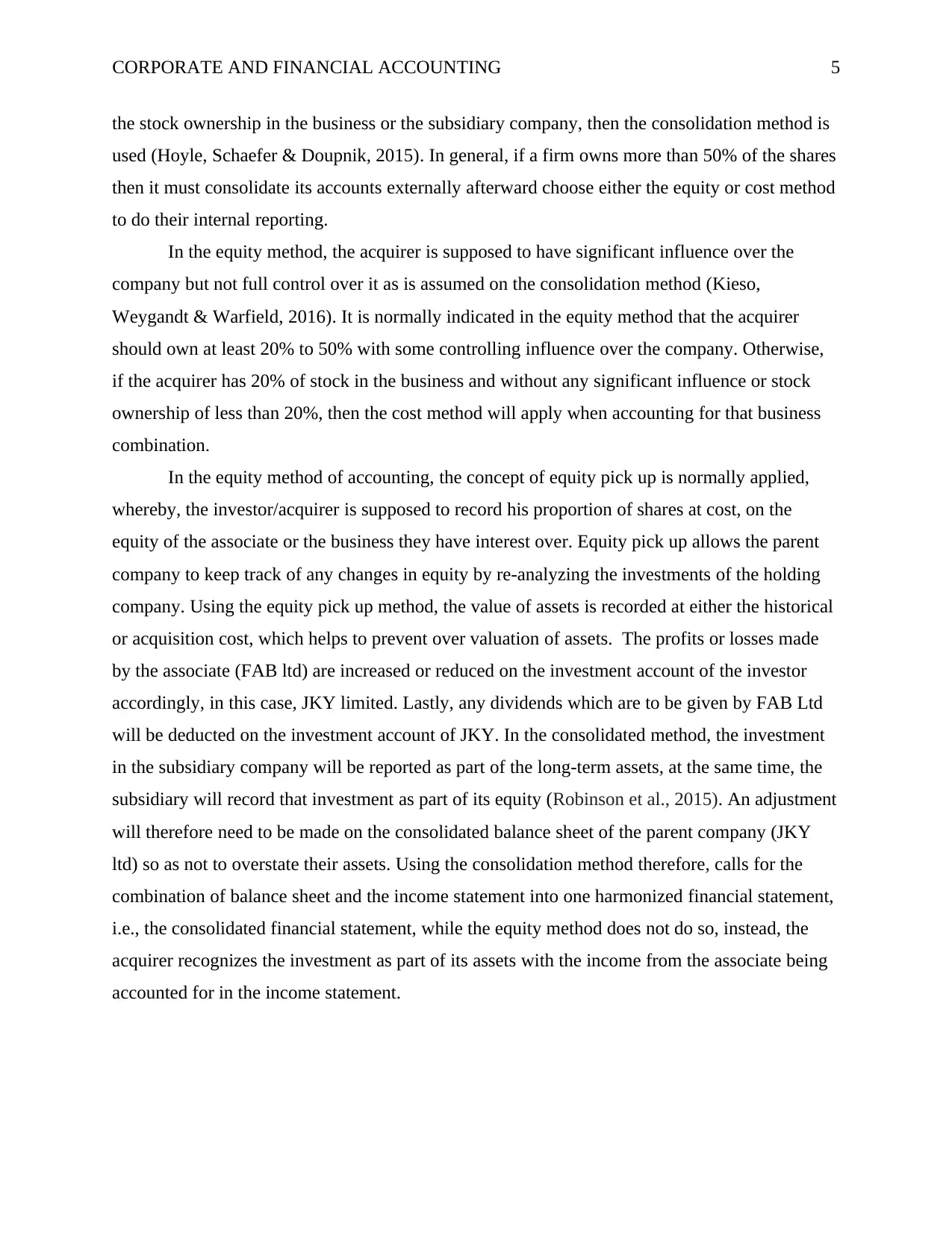
CORPORATE AND FINANCIAL ACCOUNTING 5
the stock ownership in the business or the subsidiary company, then the consolidation method is
used (Hoyle, Schaefer & Doupnik, 2015). In general, if a firm owns more than 50% of the shares
then it must consolidate its accounts externally afterward choose either the equity or cost method
to do their internal reporting.
In the equity method, the acquirer is supposed to have significant influence over the
company but not full control over it as is assumed on the consolidation method (Kieso,
Weygandt & Warfield, 2016). It is normally indicated in the equity method that the acquirer
should own at least 20% to 50% with some controlling influence over the company. Otherwise,
if the acquirer has 20% of stock in the business and without any significant influence or stock
ownership of less than 20%, then the cost method will apply when accounting for that business
combination.
In the equity method of accounting, the concept of equity pick up is normally applied,
whereby, the investor/acquirer is supposed to record his proportion of shares at cost, on the
equity of the associate or the business they have interest over. Equity pick up allows the parent
company to keep track of any changes in equity by re-analyzing the investments of the holding
company. Using the equity pick up method, the value of assets is recorded at either the historical
or acquisition cost, which helps to prevent over valuation of assets. The profits or losses made
by the associate (FAB ltd) are increased or reduced on the investment account of the investor
accordingly, in this case, JKY limited. Lastly, any dividends which are to be given by FAB Ltd
will be deducted on the investment account of JKY. In the consolidated method, the investment
in the subsidiary company will be reported as part of the long-term assets, at the same time, the
subsidiary will record that investment as part of its equity (Robinson et al., 2015). An adjustment
will therefore need to be made on the consolidated balance sheet of the parent company (JKY
ltd) so as not to overstate their assets. Using the consolidation method therefore, calls for the
combination of balance sheet and the income statement into one harmonized financial statement,
i.e., the consolidated financial statement, while the equity method does not do so, instead, the
acquirer recognizes the investment as part of its assets with the income from the associate being
accounted for in the income statement.
the stock ownership in the business or the subsidiary company, then the consolidation method is
used (Hoyle, Schaefer & Doupnik, 2015). In general, if a firm owns more than 50% of the shares
then it must consolidate its accounts externally afterward choose either the equity or cost method
to do their internal reporting.
In the equity method, the acquirer is supposed to have significant influence over the
company but not full control over it as is assumed on the consolidation method (Kieso,
Weygandt & Warfield, 2016). It is normally indicated in the equity method that the acquirer
should own at least 20% to 50% with some controlling influence over the company. Otherwise,
if the acquirer has 20% of stock in the business and without any significant influence or stock
ownership of less than 20%, then the cost method will apply when accounting for that business
combination.
In the equity method of accounting, the concept of equity pick up is normally applied,
whereby, the investor/acquirer is supposed to record his proportion of shares at cost, on the
equity of the associate or the business they have interest over. Equity pick up allows the parent
company to keep track of any changes in equity by re-analyzing the investments of the holding
company. Using the equity pick up method, the value of assets is recorded at either the historical
or acquisition cost, which helps to prevent over valuation of assets. The profits or losses made
by the associate (FAB ltd) are increased or reduced on the investment account of the investor
accordingly, in this case, JKY limited. Lastly, any dividends which are to be given by FAB Ltd
will be deducted on the investment account of JKY. In the consolidated method, the investment
in the subsidiary company will be reported as part of the long-term assets, at the same time, the
subsidiary will record that investment as part of its equity (Robinson et al., 2015). An adjustment
will therefore need to be made on the consolidated balance sheet of the parent company (JKY
ltd) so as not to overstate their assets. Using the consolidation method therefore, calls for the
combination of balance sheet and the income statement into one harmonized financial statement,
i.e., the consolidated financial statement, while the equity method does not do so, instead, the
acquirer recognizes the investment as part of its assets with the income from the associate being
accounted for in the income statement.
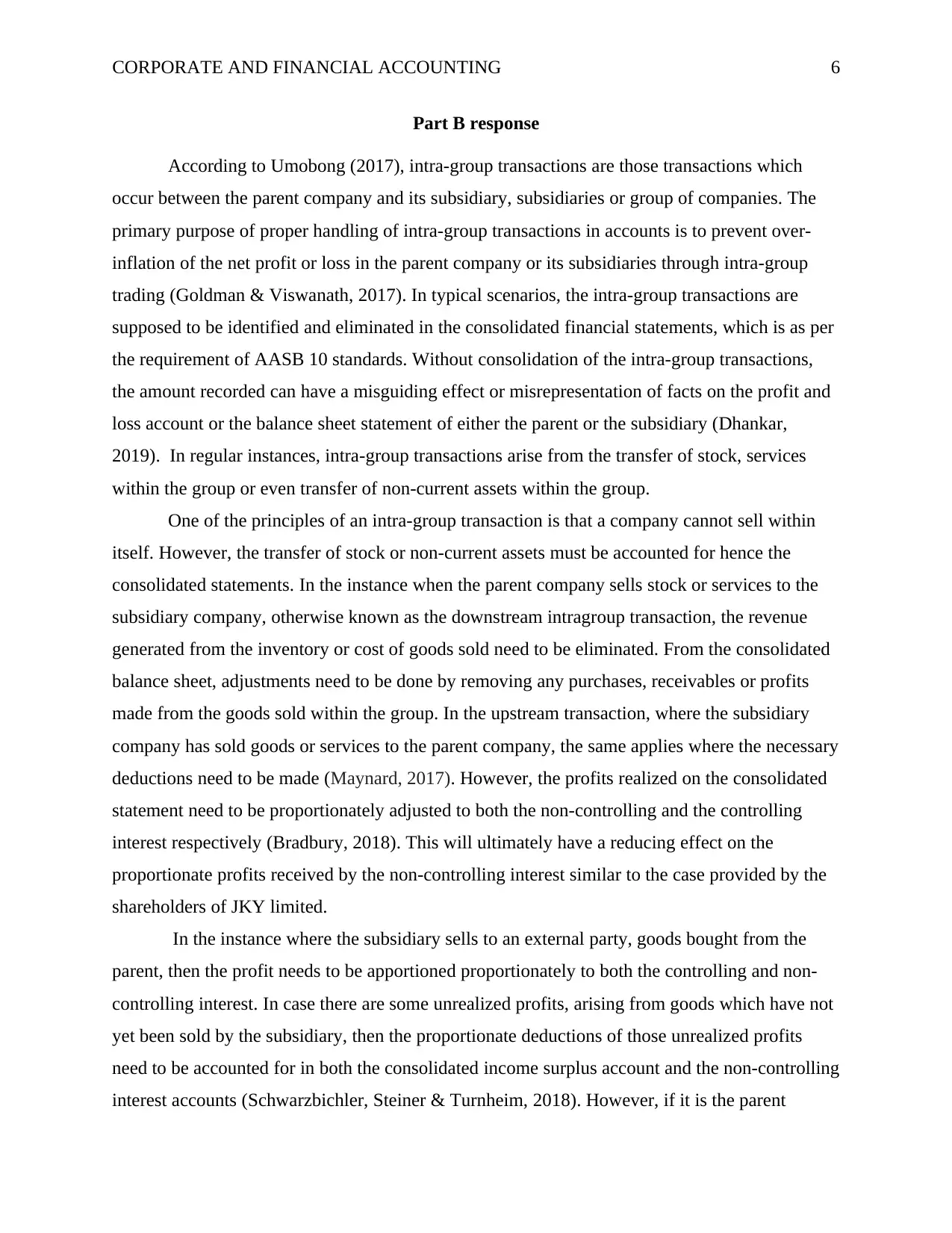
CORPORATE AND FINANCIAL ACCOUNTING 6
Part B response
According to Umobong (2017), intra-group transactions are those transactions which
occur between the parent company and its subsidiary, subsidiaries or group of companies. The
primary purpose of proper handling of intra-group transactions in accounts is to prevent over-
inflation of the net profit or loss in the parent company or its subsidiaries through intra-group
trading (Goldman & Viswanath, 2017). In typical scenarios, the intra-group transactions are
supposed to be identified and eliminated in the consolidated financial statements, which is as per
the requirement of AASB 10 standards. Without consolidation of the intra-group transactions,
the amount recorded can have a misguiding effect or misrepresentation of facts on the profit and
loss account or the balance sheet statement of either the parent or the subsidiary (Dhankar,
2019). In regular instances, intra-group transactions arise from the transfer of stock, services
within the group or even transfer of non-current assets within the group.
One of the principles of an intra-group transaction is that a company cannot sell within
itself. However, the transfer of stock or non-current assets must be accounted for hence the
consolidated statements. In the instance when the parent company sells stock or services to the
subsidiary company, otherwise known as the downstream intragroup transaction, the revenue
generated from the inventory or cost of goods sold need to be eliminated. From the consolidated
balance sheet, adjustments need to be done by removing any purchases, receivables or profits
made from the goods sold within the group. In the upstream transaction, where the subsidiary
company has sold goods or services to the parent company, the same applies where the necessary
deductions need to be made (Maynard, 2017). However, the profits realized on the consolidated
statement need to be proportionately adjusted to both the non-controlling and the controlling
interest respectively (Bradbury, 2018). This will ultimately have a reducing effect on the
proportionate profits received by the non-controlling interest similar to the case provided by the
shareholders of JKY limited.
In the instance where the subsidiary sells to an external party, goods bought from the
parent, then the profit needs to be apportioned proportionately to both the controlling and non-
controlling interest. In case there are some unrealized profits, arising from goods which have not
yet been sold by the subsidiary, then the proportionate deductions of those unrealized profits
need to be accounted for in both the consolidated income surplus account and the non-controlling
interest accounts (Schwarzbichler, Steiner & Turnheim, 2018). However, if it is the parent
Part B response
According to Umobong (2017), intra-group transactions are those transactions which
occur between the parent company and its subsidiary, subsidiaries or group of companies. The
primary purpose of proper handling of intra-group transactions in accounts is to prevent over-
inflation of the net profit or loss in the parent company or its subsidiaries through intra-group
trading (Goldman & Viswanath, 2017). In typical scenarios, the intra-group transactions are
supposed to be identified and eliminated in the consolidated financial statements, which is as per
the requirement of AASB 10 standards. Without consolidation of the intra-group transactions,
the amount recorded can have a misguiding effect or misrepresentation of facts on the profit and
loss account or the balance sheet statement of either the parent or the subsidiary (Dhankar,
2019). In regular instances, intra-group transactions arise from the transfer of stock, services
within the group or even transfer of non-current assets within the group.
One of the principles of an intra-group transaction is that a company cannot sell within
itself. However, the transfer of stock or non-current assets must be accounted for hence the
consolidated statements. In the instance when the parent company sells stock or services to the
subsidiary company, otherwise known as the downstream intragroup transaction, the revenue
generated from the inventory or cost of goods sold need to be eliminated. From the consolidated
balance sheet, adjustments need to be done by removing any purchases, receivables or profits
made from the goods sold within the group. In the upstream transaction, where the subsidiary
company has sold goods or services to the parent company, the same applies where the necessary
deductions need to be made (Maynard, 2017). However, the profits realized on the consolidated
statement need to be proportionately adjusted to both the non-controlling and the controlling
interest respectively (Bradbury, 2018). This will ultimately have a reducing effect on the
proportionate profits received by the non-controlling interest similar to the case provided by the
shareholders of JKY limited.
In the instance where the subsidiary sells to an external party, goods bought from the
parent, then the profit needs to be apportioned proportionately to both the controlling and non-
controlling interest. In case there are some unrealized profits, arising from goods which have not
yet been sold by the subsidiary, then the proportionate deductions of those unrealized profits
need to be accounted for in both the consolidated income surplus account and the non-controlling
interest accounts (Schwarzbichler, Steiner & Turnheim, 2018). However, if it is the parent
⊘ This is a preview!⊘
Do you want full access?
Subscribe today to unlock all pages.

Trusted by 1+ million students worldwide
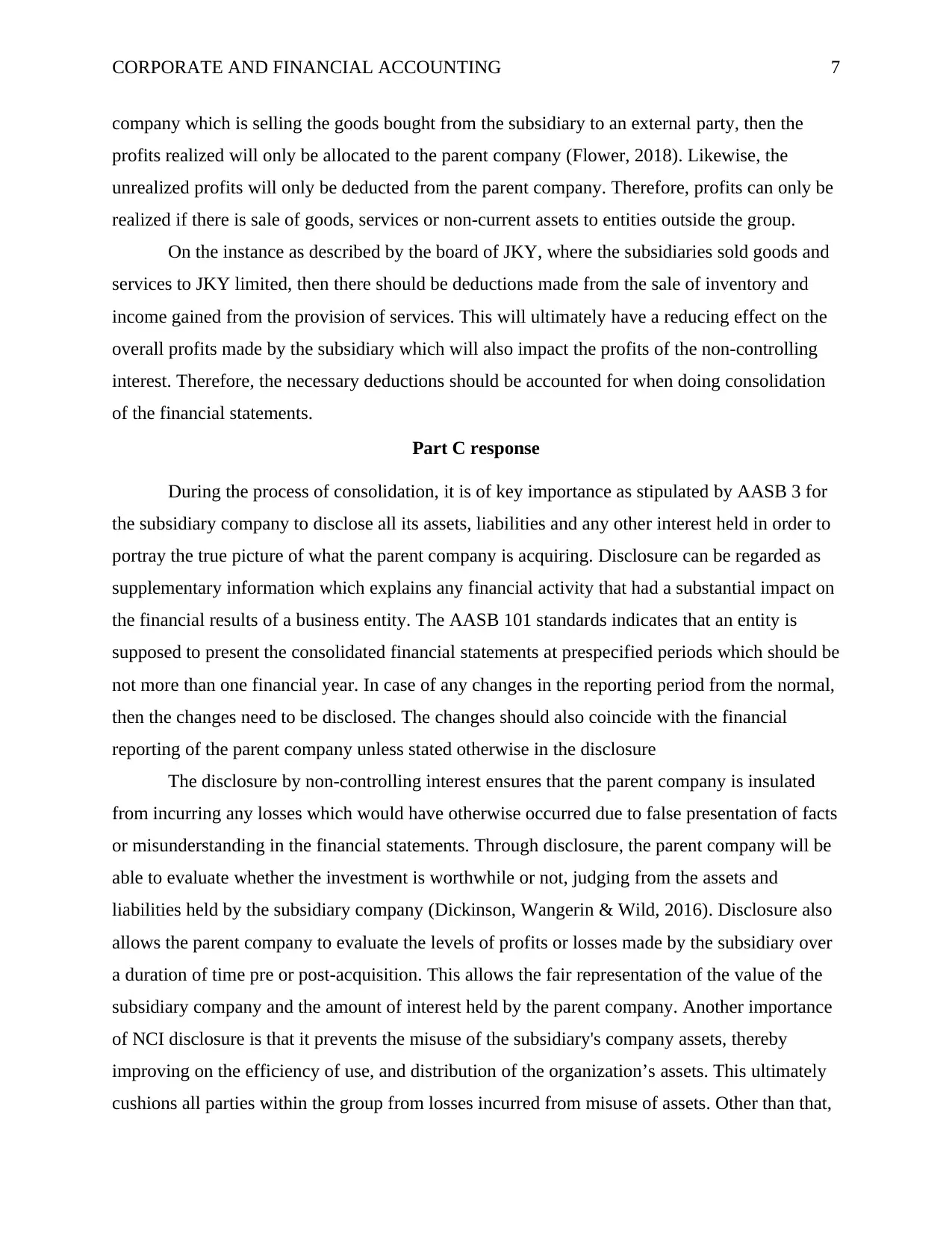
CORPORATE AND FINANCIAL ACCOUNTING 7
company which is selling the goods bought from the subsidiary to an external party, then the
profits realized will only be allocated to the parent company (Flower, 2018). Likewise, the
unrealized profits will only be deducted from the parent company. Therefore, profits can only be
realized if there is sale of goods, services or non-current assets to entities outside the group.
On the instance as described by the board of JKY, where the subsidiaries sold goods and
services to JKY limited, then there should be deductions made from the sale of inventory and
income gained from the provision of services. This will ultimately have a reducing effect on the
overall profits made by the subsidiary which will also impact the profits of the non-controlling
interest. Therefore, the necessary deductions should be accounted for when doing consolidation
of the financial statements.
Part C response
During the process of consolidation, it is of key importance as stipulated by AASB 3 for
the subsidiary company to disclose all its assets, liabilities and any other interest held in order to
portray the true picture of what the parent company is acquiring. Disclosure can be regarded as
supplementary information which explains any financial activity that had a substantial impact on
the financial results of a business entity. The AASB 101 standards indicates that an entity is
supposed to present the consolidated financial statements at prespecified periods which should be
not more than one financial year. In case of any changes in the reporting period from the normal,
then the changes need to be disclosed. The changes should also coincide with the financial
reporting of the parent company unless stated otherwise in the disclosure
The disclosure by non-controlling interest ensures that the parent company is insulated
from incurring any losses which would have otherwise occurred due to false presentation of facts
or misunderstanding in the financial statements. Through disclosure, the parent company will be
able to evaluate whether the investment is worthwhile or not, judging from the assets and
liabilities held by the subsidiary company (Dickinson, Wangerin & Wild, 2016). Disclosure also
allows the parent company to evaluate the levels of profits or losses made by the subsidiary over
a duration of time pre or post-acquisition. This allows the fair representation of the value of the
subsidiary company and the amount of interest held by the parent company. Another importance
of NCI disclosure is that it prevents the misuse of the subsidiary's company assets, thereby
improving on the efficiency of use, and distribution of the organization’s assets. This ultimately
cushions all parties within the group from losses incurred from misuse of assets. Other than that,
company which is selling the goods bought from the subsidiary to an external party, then the
profits realized will only be allocated to the parent company (Flower, 2018). Likewise, the
unrealized profits will only be deducted from the parent company. Therefore, profits can only be
realized if there is sale of goods, services or non-current assets to entities outside the group.
On the instance as described by the board of JKY, where the subsidiaries sold goods and
services to JKY limited, then there should be deductions made from the sale of inventory and
income gained from the provision of services. This will ultimately have a reducing effect on the
overall profits made by the subsidiary which will also impact the profits of the non-controlling
interest. Therefore, the necessary deductions should be accounted for when doing consolidation
of the financial statements.
Part C response
During the process of consolidation, it is of key importance as stipulated by AASB 3 for
the subsidiary company to disclose all its assets, liabilities and any other interest held in order to
portray the true picture of what the parent company is acquiring. Disclosure can be regarded as
supplementary information which explains any financial activity that had a substantial impact on
the financial results of a business entity. The AASB 101 standards indicates that an entity is
supposed to present the consolidated financial statements at prespecified periods which should be
not more than one financial year. In case of any changes in the reporting period from the normal,
then the changes need to be disclosed. The changes should also coincide with the financial
reporting of the parent company unless stated otherwise in the disclosure
The disclosure by non-controlling interest ensures that the parent company is insulated
from incurring any losses which would have otherwise occurred due to false presentation of facts
or misunderstanding in the financial statements. Through disclosure, the parent company will be
able to evaluate whether the investment is worthwhile or not, judging from the assets and
liabilities held by the subsidiary company (Dickinson, Wangerin & Wild, 2016). Disclosure also
allows the parent company to evaluate the levels of profits or losses made by the subsidiary over
a duration of time pre or post-acquisition. This allows the fair representation of the value of the
subsidiary company and the amount of interest held by the parent company. Another importance
of NCI disclosure is that it prevents the misuse of the subsidiary's company assets, thereby
improving on the efficiency of use, and distribution of the organization’s assets. This ultimately
cushions all parties within the group from losses incurred from misuse of assets. Other than that,
Paraphrase This Document
Need a fresh take? Get an instant paraphrase of this document with our AI Paraphraser
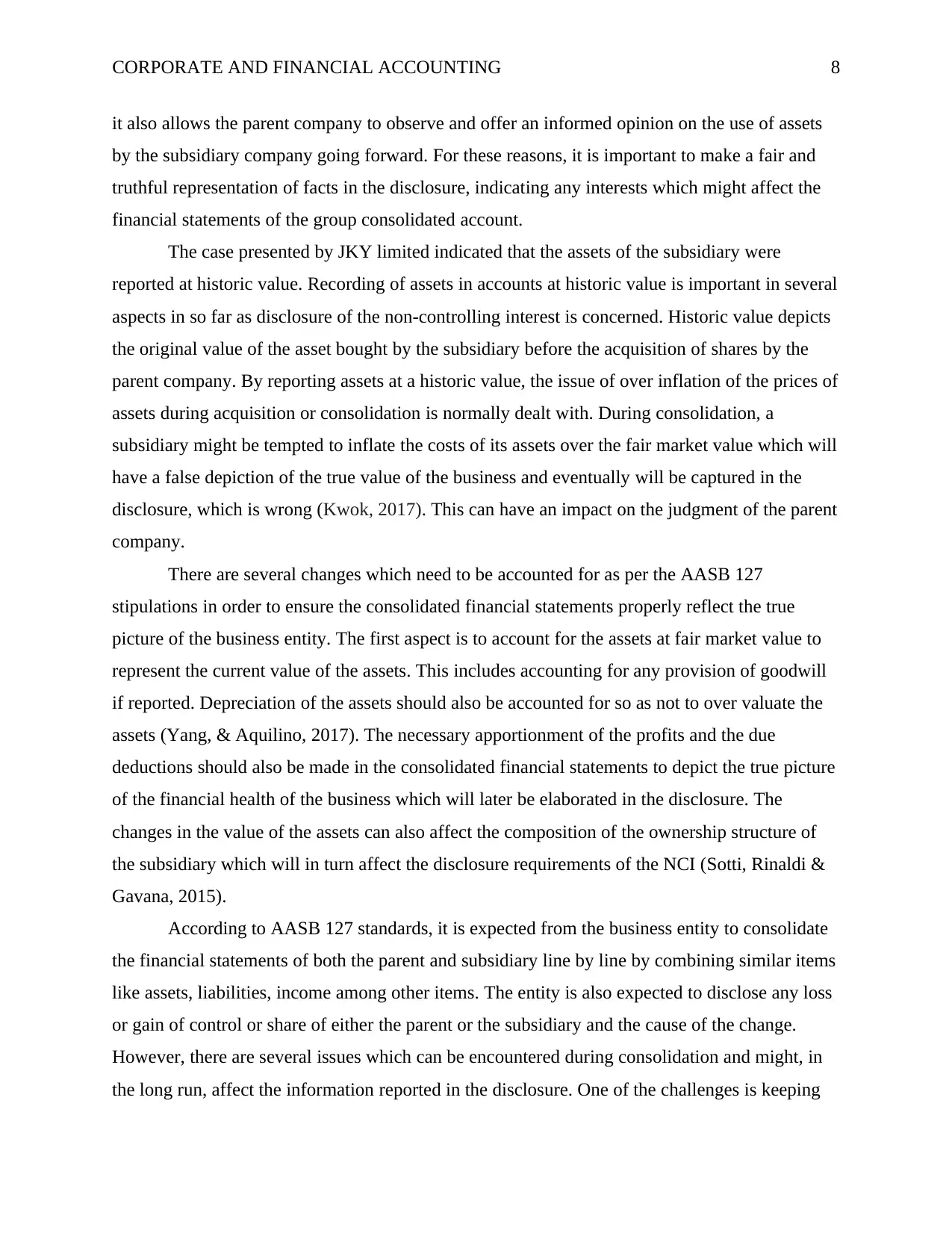
CORPORATE AND FINANCIAL ACCOUNTING 8
it also allows the parent company to observe and offer an informed opinion on the use of assets
by the subsidiary company going forward. For these reasons, it is important to make a fair and
truthful representation of facts in the disclosure, indicating any interests which might affect the
financial statements of the group consolidated account.
The case presented by JKY limited indicated that the assets of the subsidiary were
reported at historic value. Recording of assets in accounts at historic value is important in several
aspects in so far as disclosure of the non-controlling interest is concerned. Historic value depicts
the original value of the asset bought by the subsidiary before the acquisition of shares by the
parent company. By reporting assets at a historic value, the issue of over inflation of the prices of
assets during acquisition or consolidation is normally dealt with. During consolidation, a
subsidiary might be tempted to inflate the costs of its assets over the fair market value which will
have a false depiction of the true value of the business and eventually will be captured in the
disclosure, which is wrong (Kwok, 2017). This can have an impact on the judgment of the parent
company.
There are several changes which need to be accounted for as per the AASB 127
stipulations in order to ensure the consolidated financial statements properly reflect the true
picture of the business entity. The first aspect is to account for the assets at fair market value to
represent the current value of the assets. This includes accounting for any provision of goodwill
if reported. Depreciation of the assets should also be accounted for so as not to over valuate the
assets (Yang, & Aquilino, 2017). The necessary apportionment of the profits and the due
deductions should also be made in the consolidated financial statements to depict the true picture
of the financial health of the business which will later be elaborated in the disclosure. The
changes in the value of the assets can also affect the composition of the ownership structure of
the subsidiary which will in turn affect the disclosure requirements of the NCI (Sotti, Rinaldi &
Gavana, 2015).
According to AASB 127 standards, it is expected from the business entity to consolidate
the financial statements of both the parent and subsidiary line by line by combining similar items
like assets, liabilities, income among other items. The entity is also expected to disclose any loss
or gain of control or share of either the parent or the subsidiary and the cause of the change.
However, there are several issues which can be encountered during consolidation and might, in
the long run, affect the information reported in the disclosure. One of the challenges is keeping
it also allows the parent company to observe and offer an informed opinion on the use of assets
by the subsidiary company going forward. For these reasons, it is important to make a fair and
truthful representation of facts in the disclosure, indicating any interests which might affect the
financial statements of the group consolidated account.
The case presented by JKY limited indicated that the assets of the subsidiary were
reported at historic value. Recording of assets in accounts at historic value is important in several
aspects in so far as disclosure of the non-controlling interest is concerned. Historic value depicts
the original value of the asset bought by the subsidiary before the acquisition of shares by the
parent company. By reporting assets at a historic value, the issue of over inflation of the prices of
assets during acquisition or consolidation is normally dealt with. During consolidation, a
subsidiary might be tempted to inflate the costs of its assets over the fair market value which will
have a false depiction of the true value of the business and eventually will be captured in the
disclosure, which is wrong (Kwok, 2017). This can have an impact on the judgment of the parent
company.
There are several changes which need to be accounted for as per the AASB 127
stipulations in order to ensure the consolidated financial statements properly reflect the true
picture of the business entity. The first aspect is to account for the assets at fair market value to
represent the current value of the assets. This includes accounting for any provision of goodwill
if reported. Depreciation of the assets should also be accounted for so as not to over valuate the
assets (Yang, & Aquilino, 2017). The necessary apportionment of the profits and the due
deductions should also be made in the consolidated financial statements to depict the true picture
of the financial health of the business which will later be elaborated in the disclosure. The
changes in the value of the assets can also affect the composition of the ownership structure of
the subsidiary which will in turn affect the disclosure requirements of the NCI (Sotti, Rinaldi &
Gavana, 2015).
According to AASB 127 standards, it is expected from the business entity to consolidate
the financial statements of both the parent and subsidiary line by line by combining similar items
like assets, liabilities, income among other items. The entity is also expected to disclose any loss
or gain of control or share of either the parent or the subsidiary and the cause of the change.
However, there are several issues which can be encountered during consolidation and might, in
the long run, affect the information reported in the disclosure. One of the challenges is keeping
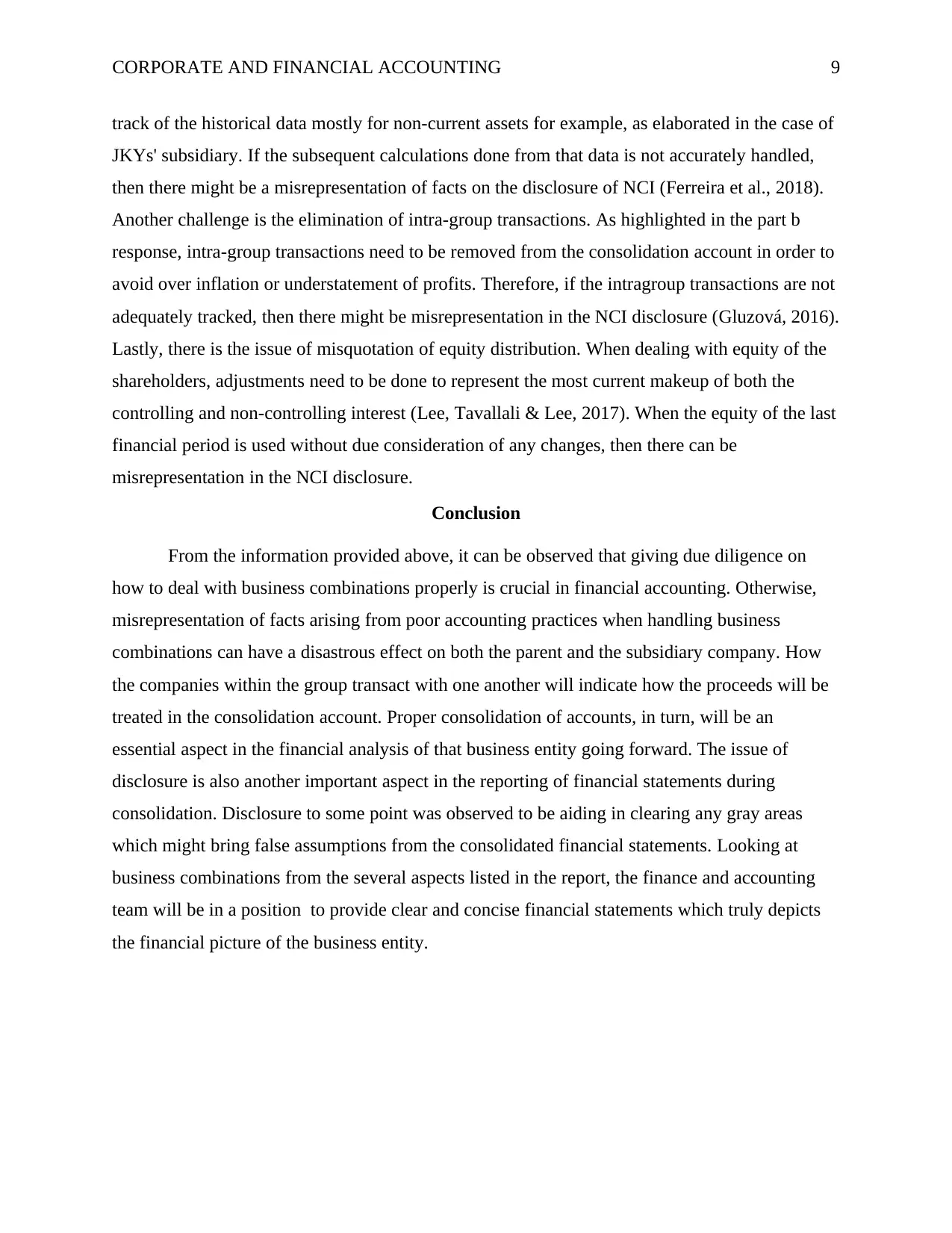
CORPORATE AND FINANCIAL ACCOUNTING 9
track of the historical data mostly for non-current assets for example, as elaborated in the case of
JKYs' subsidiary. If the subsequent calculations done from that data is not accurately handled,
then there might be a misrepresentation of facts on the disclosure of NCI (Ferreira et al., 2018).
Another challenge is the elimination of intra-group transactions. As highlighted in the part b
response, intra-group transactions need to be removed from the consolidation account in order to
avoid over inflation or understatement of profits. Therefore, if the intragroup transactions are not
adequately tracked, then there might be misrepresentation in the NCI disclosure (Gluzová, 2016).
Lastly, there is the issue of misquotation of equity distribution. When dealing with equity of the
shareholders, adjustments need to be done to represent the most current makeup of both the
controlling and non-controlling interest (Lee, Tavallali & Lee, 2017). When the equity of the last
financial period is used without due consideration of any changes, then there can be
misrepresentation in the NCI disclosure.
Conclusion
From the information provided above, it can be observed that giving due diligence on
how to deal with business combinations properly is crucial in financial accounting. Otherwise,
misrepresentation of facts arising from poor accounting practices when handling business
combinations can have a disastrous effect on both the parent and the subsidiary company. How
the companies within the group transact with one another will indicate how the proceeds will be
treated in the consolidation account. Proper consolidation of accounts, in turn, will be an
essential aspect in the financial analysis of that business entity going forward. The issue of
disclosure is also another important aspect in the reporting of financial statements during
consolidation. Disclosure to some point was observed to be aiding in clearing any gray areas
which might bring false assumptions from the consolidated financial statements. Looking at
business combinations from the several aspects listed in the report, the finance and accounting
team will be in a position to provide clear and concise financial statements which truly depicts
the financial picture of the business entity.
track of the historical data mostly for non-current assets for example, as elaborated in the case of
JKYs' subsidiary. If the subsequent calculations done from that data is not accurately handled,
then there might be a misrepresentation of facts on the disclosure of NCI (Ferreira et al., 2018).
Another challenge is the elimination of intra-group transactions. As highlighted in the part b
response, intra-group transactions need to be removed from the consolidation account in order to
avoid over inflation or understatement of profits. Therefore, if the intragroup transactions are not
adequately tracked, then there might be misrepresentation in the NCI disclosure (Gluzová, 2016).
Lastly, there is the issue of misquotation of equity distribution. When dealing with equity of the
shareholders, adjustments need to be done to represent the most current makeup of both the
controlling and non-controlling interest (Lee, Tavallali & Lee, 2017). When the equity of the last
financial period is used without due consideration of any changes, then there can be
misrepresentation in the NCI disclosure.
Conclusion
From the information provided above, it can be observed that giving due diligence on
how to deal with business combinations properly is crucial in financial accounting. Otherwise,
misrepresentation of facts arising from poor accounting practices when handling business
combinations can have a disastrous effect on both the parent and the subsidiary company. How
the companies within the group transact with one another will indicate how the proceeds will be
treated in the consolidation account. Proper consolidation of accounts, in turn, will be an
essential aspect in the financial analysis of that business entity going forward. The issue of
disclosure is also another important aspect in the reporting of financial statements during
consolidation. Disclosure to some point was observed to be aiding in clearing any gray areas
which might bring false assumptions from the consolidated financial statements. Looking at
business combinations from the several aspects listed in the report, the finance and accounting
team will be in a position to provide clear and concise financial statements which truly depicts
the financial picture of the business entity.
⊘ This is a preview!⊘
Do you want full access?
Subscribe today to unlock all pages.

Trusted by 1+ million students worldwide
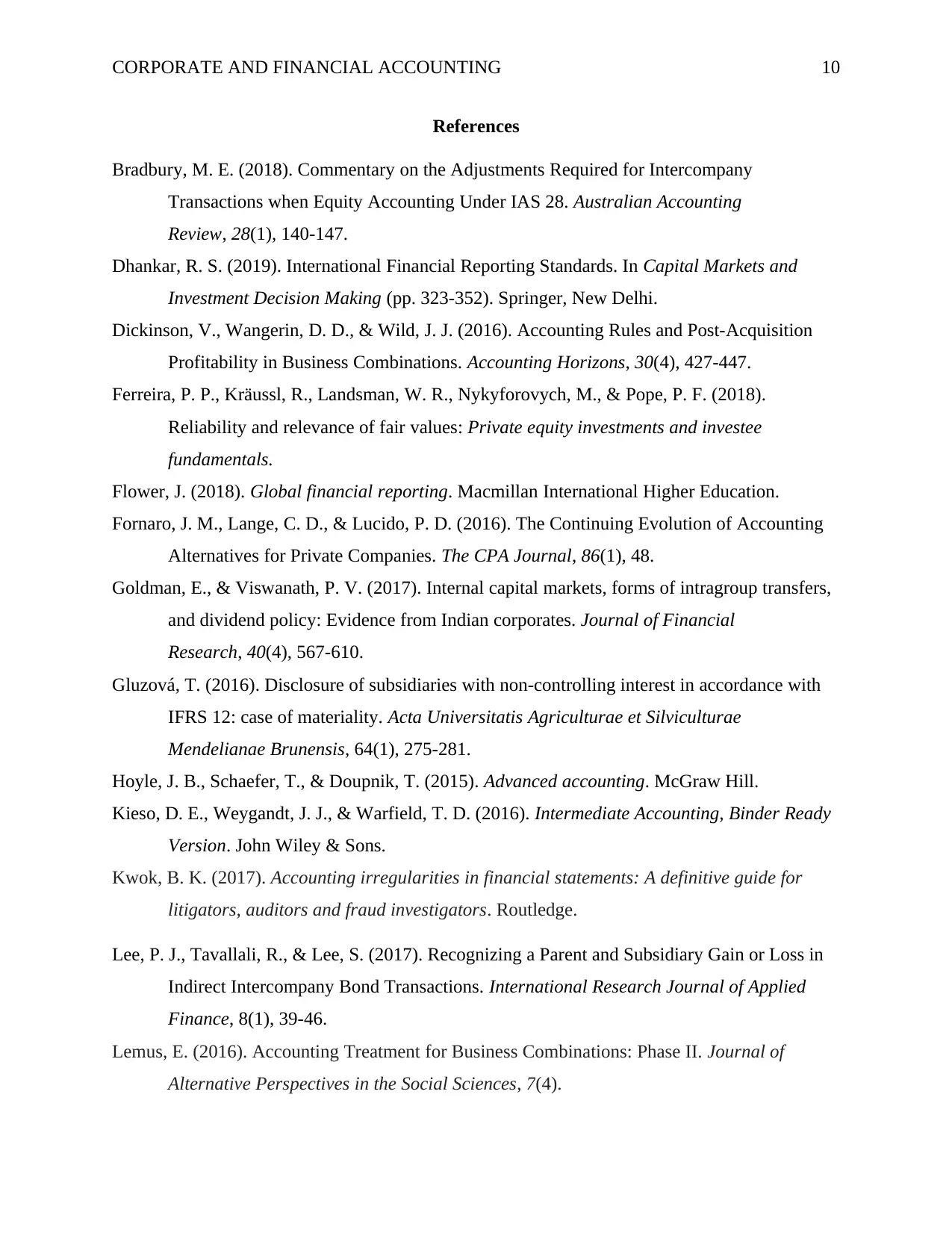
CORPORATE AND FINANCIAL ACCOUNTING 10
References
Bradbury, M. E. (2018). Commentary on the Adjustments Required for Intercompany
Transactions when Equity Accounting Under IAS 28. Australian Accounting
Review, 28(1), 140-147.
Dhankar, R. S. (2019). International Financial Reporting Standards. In Capital Markets and
Investment Decision Making (pp. 323-352). Springer, New Delhi.
Dickinson, V., Wangerin, D. D., & Wild, J. J. (2016). Accounting Rules and Post-Acquisition
Profitability in Business Combinations. Accounting Horizons, 30(4), 427-447.
Ferreira, P. P., Kräussl, R., Landsman, W. R., Nykyforovych, M., & Pope, P. F. (2018).
Reliability and relevance of fair values: Private equity investments and investee
fundamentals.
Flower, J. (2018). Global financial reporting. Macmillan International Higher Education.
Fornaro, J. M., Lange, C. D., & Lucido, P. D. (2016). The Continuing Evolution of Accounting
Alternatives for Private Companies. The CPA Journal, 86(1), 48.
Goldman, E., & Viswanath, P. V. (2017). Internal capital markets, forms of intragroup transfers,
and dividend policy: Evidence from Indian corporates. Journal of Financial
Research, 40(4), 567-610.
Gluzová, T. (2016). Disclosure of subsidiaries with non-controlling interest in accordance with
IFRS 12: case of materiality. Acta Universitatis Agriculturae et Silviculturae
Mendelianae Brunensis, 64(1), 275-281.
Hoyle, J. B., Schaefer, T., & Doupnik, T. (2015). Advanced accounting. McGraw Hill.
Kieso, D. E., Weygandt, J. J., & Warfield, T. D. (2016). Intermediate Accounting, Binder Ready
Version. John Wiley & Sons.
Kwok, B. K. (2017). Accounting irregularities in financial statements: A definitive guide for
litigators, auditors and fraud investigators. Routledge.
Lee, P. J., Tavallali, R., & Lee, S. (2017). Recognizing a Parent and Subsidiary Gain or Loss in
Indirect Intercompany Bond Transactions. International Research Journal of Applied
Finance, 8(1), 39-46.
Lemus, E. (2016). Accounting Treatment for Business Combinations: Phase II. Journal of
Alternative Perspectives in the Social Sciences, 7(4).
References
Bradbury, M. E. (2018). Commentary on the Adjustments Required for Intercompany
Transactions when Equity Accounting Under IAS 28. Australian Accounting
Review, 28(1), 140-147.
Dhankar, R. S. (2019). International Financial Reporting Standards. In Capital Markets and
Investment Decision Making (pp. 323-352). Springer, New Delhi.
Dickinson, V., Wangerin, D. D., & Wild, J. J. (2016). Accounting Rules and Post-Acquisition
Profitability in Business Combinations. Accounting Horizons, 30(4), 427-447.
Ferreira, P. P., Kräussl, R., Landsman, W. R., Nykyforovych, M., & Pope, P. F. (2018).
Reliability and relevance of fair values: Private equity investments and investee
fundamentals.
Flower, J. (2018). Global financial reporting. Macmillan International Higher Education.
Fornaro, J. M., Lange, C. D., & Lucido, P. D. (2016). The Continuing Evolution of Accounting
Alternatives for Private Companies. The CPA Journal, 86(1), 48.
Goldman, E., & Viswanath, P. V. (2017). Internal capital markets, forms of intragroup transfers,
and dividend policy: Evidence from Indian corporates. Journal of Financial
Research, 40(4), 567-610.
Gluzová, T. (2016). Disclosure of subsidiaries with non-controlling interest in accordance with
IFRS 12: case of materiality. Acta Universitatis Agriculturae et Silviculturae
Mendelianae Brunensis, 64(1), 275-281.
Hoyle, J. B., Schaefer, T., & Doupnik, T. (2015). Advanced accounting. McGraw Hill.
Kieso, D. E., Weygandt, J. J., & Warfield, T. D. (2016). Intermediate Accounting, Binder Ready
Version. John Wiley & Sons.
Kwok, B. K. (2017). Accounting irregularities in financial statements: A definitive guide for
litigators, auditors and fraud investigators. Routledge.
Lee, P. J., Tavallali, R., & Lee, S. (2017). Recognizing a Parent and Subsidiary Gain or Loss in
Indirect Intercompany Bond Transactions. International Research Journal of Applied
Finance, 8(1), 39-46.
Lemus, E. (2016). Accounting Treatment for Business Combinations: Phase II. Journal of
Alternative Perspectives in the Social Sciences, 7(4).
Paraphrase This Document
Need a fresh take? Get an instant paraphrase of this document with our AI Paraphraser
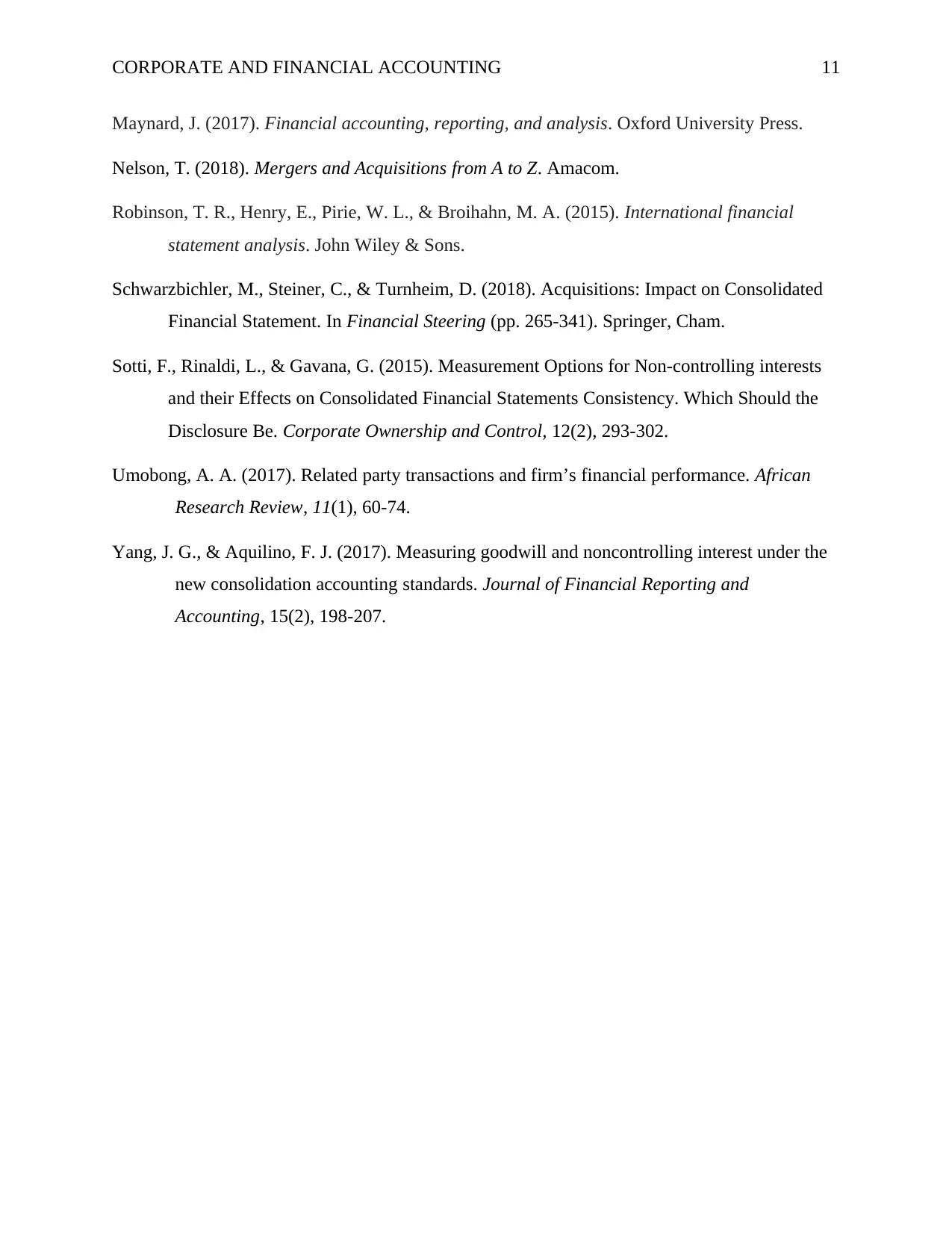
CORPORATE AND FINANCIAL ACCOUNTING 11
Maynard, J. (2017). Financial accounting, reporting, and analysis. Oxford University Press.
Nelson, T. (2018). Mergers and Acquisitions from A to Z. Amacom.
Robinson, T. R., Henry, E., Pirie, W. L., & Broihahn, M. A. (2015). International financial
statement analysis. John Wiley & Sons.
Schwarzbichler, M., Steiner, C., & Turnheim, D. (2018). Acquisitions: Impact on Consolidated
Financial Statement. In Financial Steering (pp. 265-341). Springer, Cham.
Sotti, F., Rinaldi, L., & Gavana, G. (2015). Measurement Options for Non-controlling interests
and their Effects on Consolidated Financial Statements Consistency. Which Should the
Disclosure Be. Corporate Ownership and Control, 12(2), 293-302.
Umobong, A. A. (2017). Related party transactions and firm’s financial performance. African
Research Review, 11(1), 60-74.
Yang, J. G., & Aquilino, F. J. (2017). Measuring goodwill and noncontrolling interest under the
new consolidation accounting standards. Journal of Financial Reporting and
Accounting, 15(2), 198-207.
Maynard, J. (2017). Financial accounting, reporting, and analysis. Oxford University Press.
Nelson, T. (2018). Mergers and Acquisitions from A to Z. Amacom.
Robinson, T. R., Henry, E., Pirie, W. L., & Broihahn, M. A. (2015). International financial
statement analysis. John Wiley & Sons.
Schwarzbichler, M., Steiner, C., & Turnheim, D. (2018). Acquisitions: Impact on Consolidated
Financial Statement. In Financial Steering (pp. 265-341). Springer, Cham.
Sotti, F., Rinaldi, L., & Gavana, G. (2015). Measurement Options for Non-controlling interests
and their Effects on Consolidated Financial Statements Consistency. Which Should the
Disclosure Be. Corporate Ownership and Control, 12(2), 293-302.
Umobong, A. A. (2017). Related party transactions and firm’s financial performance. African
Research Review, 11(1), 60-74.
Yang, J. G., & Aquilino, F. J. (2017). Measuring goodwill and noncontrolling interest under the
new consolidation accounting standards. Journal of Financial Reporting and
Accounting, 15(2), 198-207.
1 out of 11
Related Documents
Your All-in-One AI-Powered Toolkit for Academic Success.
+13062052269
info@desklib.com
Available 24*7 on WhatsApp / Email
![[object Object]](/_next/static/media/star-bottom.7253800d.svg)
Unlock your academic potential
Copyright © 2020–2025 A2Z Services. All Rights Reserved. Developed and managed by ZUCOL.




